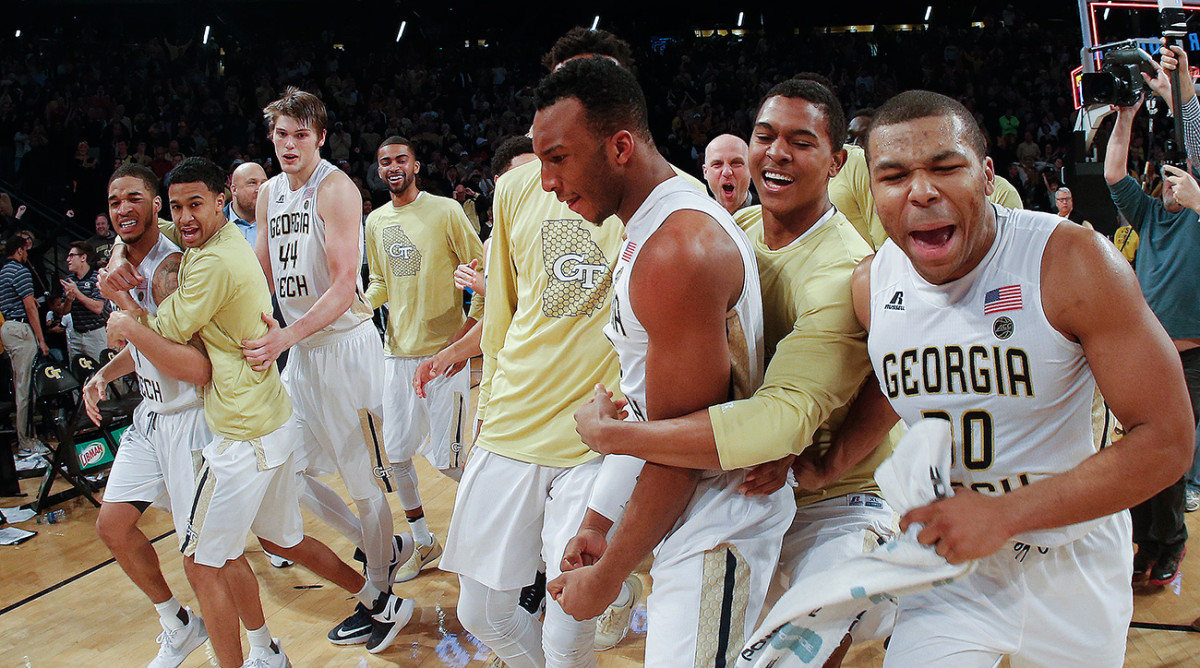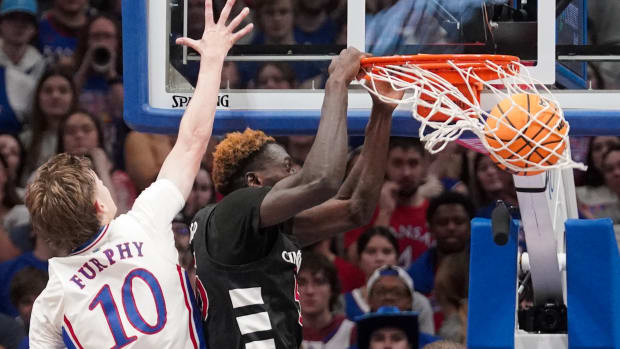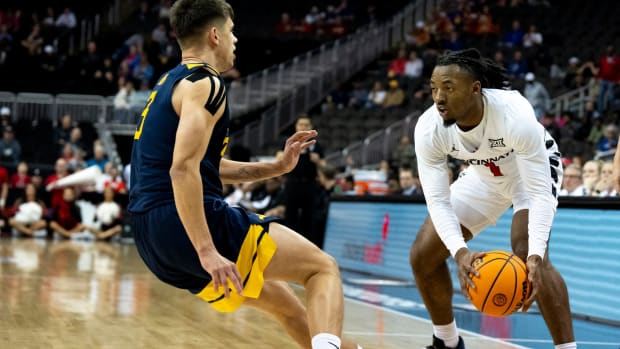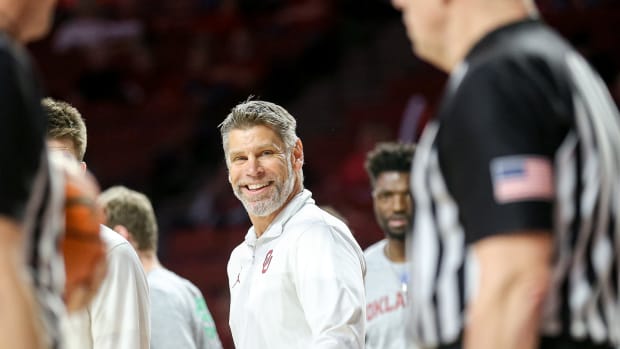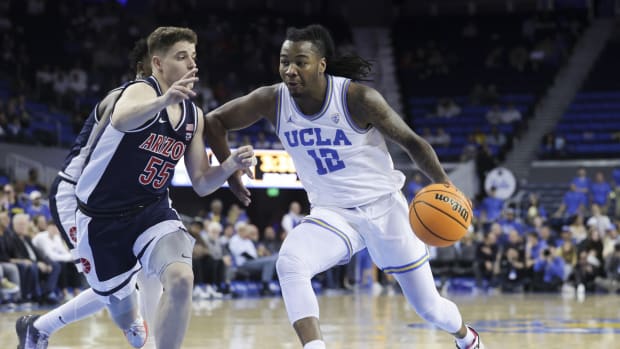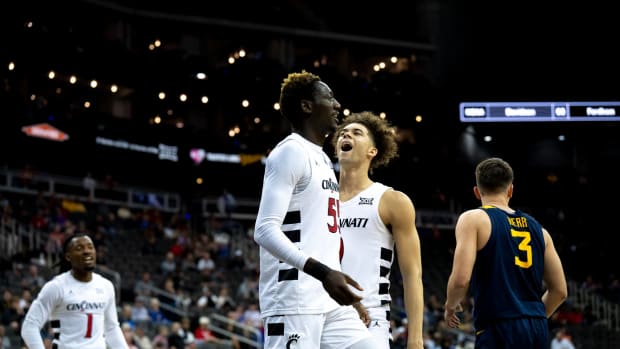Bubble Watch: Power conferences crowding the NCAA tournament field
As the calendar turns to February, power conference bubble teams are in better overall shape than they’ve been in years. The Atlantic 10 looks like it might only put one team into the NCAA tournament, the conference’s fewest since 2005. The AAC isn’t likely to have more than two teams in the field of 68. The Mountain West is guaranteed to be a one-bid league. The Missouri Valley could send both Illinois State and Wichita State to the NCAA tournament, but that could change if the Redbirds win in Wichita this weekend. With just less than six weeks before Selection Sunday, it’s not bad to be a bubble team, so long as you’re in one of the country’s six premier conferences.
American
Lock: Cincinnati
SMU’s (18–4, 8–1) days in the Bubble Watch are numbered, and that’s good news for the Mustangs. They’ve handled their business in the AAC, with their only loss among their nine conference games coming to Cincinnati. It’s not an overwhelmingly strong résumé—their best nonconference wins came against TCU and Pittsburgh, but it will get the Mustangs into the Big Dance, likely as a middle seed (No. 6 through No. 9).
Beyond the conference’s top two teams, there are just four more that can even think about an at-large berth. The path to the tournament for every down-ticket team in the conference is the same. Dominate the bottom of the conference and pick off one win over Cincinnati or SMU. That won’t guarantee entry, but it will give any of the four possible bubblers legitimate hope on Selection Sunday. That’s what made Memphis’s (16–6, 6–3) loss to Temple last week so disheartening. Taken on its own, it isn’t a terrible loss. The problem, however, is that Memphis can now probably only afford two more losses before its résumé has too many holes.
Bracket Watch: How the field looks after a week of upsets
Houston (15–7, 6–4) got right last week with wins over Tulane and Temple. The Cougars have four losses in conference, but none is a true blot. A home loss to Memphis could be the one that they regret most, but if they’re in a position to point to one loss as their death knell, it will mean that they played great basketball over the second half of conference play. They have just one game this week, against a UCF (14–7, 5–4) team that is also a couple of wins away from being a realistic at-large contender. The Knights have lost three straight games to Memphis, SMU and Tulsa, with the first and third of those coming on the road. By Feb. 8, we’ll know if UCF is in the at-large hunt or heading toward the NIT. Their next three games are against Houston, Memphis and Cincinnati.
Finally, we’d be remiss if we did not mention Tulsa (12–8, 6–2), even though the tournament field would need to be about 76 teams deep for the Golden Hurricane to have a chance with its present résumé. The reason they’re in the Bubble Watch for the first time all season, then? They’re 6–2 with home games against Cincinnati and SMU this week. If they can somehow win both of those, we’ll have to take them seriously as a bubble team. If they split, they’ll at least be on the fringes of the discussion. If they lose both, well, then we’ll point to their three losses to teams with kenpom.com ratings of 183 or worse and call it a day.
Atlantic 10
VCU’s (16–5, 6–2) win over Dayton (15–5, 6–2) last weekend produced two results. First, it strengthened VCU’s at-large candidacy, vaulting the Rams from our First Four Out in last week’s Bracket Watch to a No. 10 seed this week. Second, it called into question the safety of Dayton’s at-large bid. Let’s start with the Rams. This was the kind of win they’d been lacking all year. As good a team as is Middle Tennessee, which VCU beat in December, that’s not a launching-pad victory. Couple it with a win over Dayton, though, and now you have a solid foundation for an at-large bid. Now that the Rams have checked that box, the next step they need to take concerns their performance on the road. The Rams have four true road wins this season over Liberty (kenpom.com No. 184), Old Dominion (125), George Mason (138) and Duquesne (219). Their two conference losses were both on the road, at Davidson (80) and Fordham (217). They won’t play a road game against a strong at-large candidate until the last week of February, so the impact of those potential wins will be minimal. Still, they need to prove they can win on the road with consistency, regardless of the quality of the opponent. They next take to the road on Saturday when they visit St. Bonaventure. As for Dayton, it’s time to scrutinize its résumé a little further. The Flyers have been safely in our field of 68 every week, and checked in as a No. 7 seed this week. Their best win of the season, however, is over bubble-riding Rhode Island. They have one win against a team in our field of 68, and that came against Southern Conference powerhouse East Tennessee State. No offense to the Buccaneers, but a win over them isn’t exactly an NCAA tournament imprimatur. Dayton is still in strong position for an at-large bid, but that could change with a couple of bad losses. Their next three games are against Fordham, Duquesne and Saint Joseph’s. For the sake of the Flyers at-large candidacy, those all need to be comfortable victories.
Rhode Island (13–7, 5–3) dropped out of our field of 68 this week, largely thanks to a loss at Richmond on Wednesday. The Rams’ nonconference win over Cincinnati will carry them far, but they’ve racked up too many losses at this point to trade solely on that victory. It’s becoming apparent that, if the Rams are going to get into the dance without winning the A-10 tournament, they’re going to need at least one victory against Dayton or VCU. They host George Washington and visit Davidson this week.
Richmond (13–8, 7–2) is atop the A-10 standings, which earns the Spiders a mention in the Bubble Watch. Before anyone gets too fired up about the Spiders dancing for the first time since 2011, understand that they have three losses to teams ranked 125th or worse on kenpom.com, which matches their number of top-100 wins. Their performance in the first half of the A-10 season is noteworthy, but they can’t simply stay the course to get into the field of 68. They’re going to have to add one or two headline-grabbing wins, and can start that on Wednesday with a trip to VCU.
St. Bonaventure (13–7, 5–3) and La Salle (11–8, 5–3) had both been discussed in previous editions of the Bubble Watch, but we can safely put both to the side. The Bonnies are a classic good bad team, with all 13 of their wins coming against teams with kenpom.com rankings of 130 or worse. La Salle, meanwhile, has lost three straight games, with the last two against Penn and Saint Joseph’s.
ACC
Locks: North Carolina, Virginia, Florida State, Louisville, Notre Dame, Duke
As has become our pattern for handling a conference as loaded as this season’s ACC, we’ll start their section with the team that had the best week. That was, unquestionably, Georgia Tech (13–8, 5–4). The Yellow Jackets crushed Florida State by 22 points on Wednesday and then won a thriller over Notre Dame on Saturday on a buzzer-beating layup by Josh Okogie. The wins moved Georgia Tech above .500 in the ACC and added to their impressive win over North Carolina on Dec. 31. Add in second-tier wins over Clemson, VCU and NC State, and it’s hard to keep the Yellow Jackets out of the field of 68. Remember, every single bubble team has its flaws. Not all of them also have wins over three teams that will likely earn top-25 seeds. Georgia Tech has more than counterbalanced their flaws. They should be considered an at-large team right now.
Next up is Miami (14–6, 4–4), which had to squeak out a one-point win at home over Boston College, but then cruised to a 15-point victory over North Carolina three days later. Miami has been on the border of the field all season, routinely bouncing between the Last Four In and First Four Out. A win over a team like North Carolina gives the Hurricanes some breathing room. It doesn’t lock them into the field by any stretch of the imagination, but they are a No. 11 seed in this week’s Bracket Watch, playing their way out of the First Four in Dayton. That could change quickly, however, with one of the most brutal possible schedules awaiting them the rest of the season. Nine of their 10 remaining games are against teams in our field of 68, with five of those against Florida State, Louisville, Virginia and Duke.
We’re going to leave the field of 68 for our next team because, frankly, it forced our hand with a huge week. Syracuse (13–9, 5–4) still has plenty of work to do to get in the field, but wins over Wake Forest and Florida State woke up what had been a moribund team. The Orange can’t simply wave a magic wand and make losses to Connecticut, St. John’s and Boston College disappear but, like Georgia Tech, they proved that they can beat high-level tournament teams this week. That’s a differentiator for any team on the bubble. For example, let’s spin the season forward and say Syracuse finishes at 9–9 in the ACC—which would require them to go 4–5 the rest of the way—adding one win over Louisville, with all five losses coming to tourney teams. Would that give them a better résumé than, say, a VCU team that goes 14–4 in the A-10, with its best win coming over Dayton? Your answer to that question will be determined by what you value most in a possible tournament team. If it’s wins over elite competition, Syracuse will have a leg up. Of course, they need to get those wins before this discussion becomes a reality. They visit NC State and host Virginia this week.
No other bubble team in the conference had a standout week, so we’ll now take them in s-curve order, with the highest seed first. Virginia Tech (16–5, 5–4) played to script this week, losing by 19 at North Carolina before earning a relatively comfortable win over Boston College at home. The Hokies are in solid at-large position, but they’re about to have the heat turned up over the next few weeks. Four of their next five games are against Virginia (away), Miami (away), Virginia again and Louisville (away). In other words, that position could look a whole lot different a few Bubble Watches from now.
Hoop Thoughts: Inside the decision to create a midseason bracket show
Wake Forest (12–9, 3–6) had a heartbreaking week, losing to Syracuse and Duke. The Demon Deacons led Duke for all but 6.6 seconds in the final 30 minutes of their matchup Saturday. Unfortunately, the 6.6 seconds were the final 6.6 seconds of the game. Wake may eventually remember Luke Kennard’s game-winning three as the shot that sunk its season. A win over Duke could have been the foundation from which the Demon Deacons built an at-large résumé. As it stands, they’re still looking for that win. Their ACC schedule was front-loaded, though, meaning they have precious few opportunities to really build their résumé the rest of the year. They have just three games left with the conference’s no-doubt tourney teams, starting with Notre Dame next week.
Clemson (12–8, 2–6) snapped a six-game losing streak with a win at Pittsburgh on Saturday. We’ve already said this a few times this season, but it bears repeating: It’s nearly impossible to watch Clemson and come away with the impression that they aren’t one of the 36 best teams in the country, once you take away the automatic qualifiers. That’s the standard by which teams earn at-large berths, so Clemson should be in good shape. Unfortunately, the committee is unlikely to take a team with 11 losses in its conference, no matter who it is. That gives Clemson its marching orders. The Tigers likely need at least eight more wins, including the ACC tournament, to have a real shot at an at-large bid. The standard could change depending on the makeup of those wins, but that should be the starting point. That effort begins this week with games against Georgia Tech and Florida State.
NC State (14–8, 3–6) had a net positive week, beating Duke and losing to Louisville. The Wolfpack are in a position similar to Clemson and Wake Forest, though they have a win over one of the surefire tourney teams in the conference, something neither the Tigers nor Demon Deacons can claim. Given that volume of wins in a conference like the ACC matters more than it does in the AAC or Atlantic 10, the Wolfpack can take major strides toward the Dance this week when they host winnable games against Syracuse and Miami.
Finally, Pittsburgh (12–9, 1–7) has serious work to do to get back on the at-large radar. After losing to Louisville and Clemson at home last week, the Panthers are 1–7 in the ACC. Coming up this week is a trip to Tobacco Road, with games at North Carolina and Duke. Losses in both of those would end the Panthers fledgling at-large hopes.
Big 12
Locks: Baylor, Kansas, West Virginia
The first meeting between Baylor and Kansas will rightfully get the attention in the Big 12 this week, but we’re not concerned with that in the Bubble Watch. What we are concerned with is the terrible week just turned in by the conference’s bubble teams as a whole. The worst week belonged to TCU (14–7, 3–5), which suffered an understandable loss at Oklahoma State, but then dropped a home game to a middling-at-best Auburn team. The losses forced the Horned Frogs out of our field of 68 this week. Two weeks ago, they were 3–2 in the Big 12, with their only losses on the season coming at the hands of Kansas, West Virginia and SMU. They’ve lost four straight games since then, with just one coming to a team that will definitely be in the NCAA tournament (Baylor). TCU is now looking at an uphill climb in conference, likely needing to go at least 6–4 in their final 10 games of the season with one matchup remaining against each of the conference’s elite. You can do the math here. TCU will have to upset Baylor, Kansas or West Virginia, absolutely dominate the rest of the conference, or pull off a combination of the two, to get an at-large bid.
Kansas State’s (15–6, 4–4) week wasn’t much better. The Wildcats, as is their wont, struggled on the road, losing at Iowa State and Tennessee. They’re in better shape than TCU because they’ve already banked a win over West Virginia, but an at-large bid could slip away from them just as easily. Wednesday’s game against TCU, in fact, is crucial for both teams. We already know what it means to the Horned Frogs. After the matchup, the Wildcats begin a three-game stretch against Baylor, Kansas and West Virginia, with the first and third of those games coming on the road.
How coaches could use time off as a recruiting advantage
Texas Tech (15–6, 3–5) stayed the course this week, losing a close game at Baylor before handling LSU at home. The Red Raiders didn’t do anything to help or hurt their at-large case, which was already on sound footing. They’ll take to the road for two of their next three games, but those trips are to Texas and TCU, with a home game against Oklahoma sandwiched in between. Those could be the bottom three teams in the conference, but the stretch can still serve as the proving ground the Red Raiders need to earn an at-large berth.
Iowa State (13–7, 5–3), too, kept its tourney-bound trajectory, with a win over Kansas State and a loss at Vanderbilt. The Cyclones’ second-half performance in Nashville was a letdown, but this is still a team with wins over Miami, Texas Tech, Oklahoma State and Kansas State. They step up in weight class this week, hosting West Virginia on Tuesday and visiting Kansas on Saturday. A split, no matter which one is the win, would be a great result.
Finally, Oklahoma State (14–8, 3–6) beat TCU and Arkansas last week, picking up wins over teams in the at-large hunt. The Cowboys may be just 3–6 in conference, but they now have four wins over teams that could earn at-large bids. What’s more, they still have home games left with Baylor and Kansas. After winning at Oklahoma on Monday, the Cowboys will visit West Virginia on Saturday.
Big East
Locks: Villanova, Butler, Creighton
Earlier in the column, we detailed how Dayton isn’t on quite as solid at-large ground as it appears. The poster child for that condition, however, is one of the Flyers’ southern neighbors. Xavier (15–6, 5–2) is in more trouble than it would appear after a cursory glance. Yes, the Musketeers have five wins in the Big East, which kenpom.com rates as the third-best conference in the country, trailing the ACC and Big 12. Those five wins have come against Providence, St. John’s (twice) and Georgetown (twice), the conference’s three worst teams that aren’t named DePaul. They have a decent stable of nonconference wins over Clemson, Wake Forest and Utah, but none of those teams is an NCAA tournament lock. In fact, after losing to Cincinnati last week, Xavier is just 1–5 against teams in the field of 68 in this week’s Bracket Watch. And, of course, all this was before the team announced that sophomore point guard Edmond Sumner had suffered a torn ACL and would miss the remainder of the season. Xavier’s games with Seton Hall on Wednesday and Creighton on Saturday are hugely important. It needs wins against tournament-quality teams in the worst way. It can get two this week.
After beating Creighton and Villanova, Marquette (14–7, 5–4) dropped a home game to Providence. Sure, why not? The surprising loss notwithstanding, the Golden Eagles took a quantum leap in the right direction with their upset of Villanova last week. They now have to be favored to get an at-large bid. In fact, they likely already have the necessary signature wins to get into the Dance. At this point, Marquette may just need to avoid bad losses the rest of the way.
Seton Hall (13–7, 3–5) remained one of our Last Four In the field this week after beating St. John’s and losing to Butler. One thing keeping the Pirates on shaky footing is their lack of true road wins. They have just one such victory, and that came over Iowa all the way back in November. They can take major steps toward the dance this week with road games at Xavier and Georgetown.
The conference’s fringe bubble teams had strong weeks, with both Georgetown 12–10, 3–6 and Providence (14–9, 4–6) picking up big wins. Let’s start with the Hoyas, who were down and out a week ago, but who resuscitated their season with wins over Creighton and Butler, the latter of which came on the road. The Hoyas still have a lot of work to do to get into the Dance, though. No team with more than 14 losses has ever earned an at-large bid since the tournament expanded to 64 teams in 1985, and just 23 have done so with more than 12. Georgetown may not be able to afford more than two losses the rest of the season, and they still have both of their games with Villanova remaining, the first of which comes next week. Still, they injected some life into their season with last week’s victories. The Friars did the same by knocking off Marquette in Milwaukee over the weekend. They’re in a similar position to Georgetown,. We could get a referendum on their at-large candidacy over the next 10 days, with Villanova, Seton Hall (away) and Butler up next for the Pirates.
Big Ten
Locks: Maryland, Wisconsin, Purdue
The Big Ten remains the most unpredictable conference in the country, but it is helpfully dividing into easily identifiable tiers. At the top is Wisconsin, Purdue and Maryland (and the Badgers are leading that top tier). Next up, at this point in a tier of one, is Northwestern (18–4, 7–2). The Wildcats are ranked in the top 25 for the first time since the 2009–10 season and are set to end the most ignominious streak in major college sports. Junior guard Bryant McIntosh is one of the best little-known players in the country, and Chris Collins is likely already a shoo-in for Big Ten Coach of the Year. Having said that, it’s worth noting that they have yet to play any of the top three teams in the conference. That will change shortly, with all three on the schedule in the next two weeks, starting with Purdue in West Lafayette on Wednesday. The Wildcats visit Madison to take on the Badgers on February 12, and then host Maryland on February 15.
Hoop Thoughts: Collins has Northwestern on the cusp of the NCAAs
The next tier of teams in terms of ability and ceiling is helpfully stacked after Purdue in the conference standings. Michigan State (13–9, 5–4), Indiana (14–8, 4–5) and Michigan (14–8, 4–5) all looks like tourney teams. The issue for all three will be playing with enough consistency to stay one step in front of the bubble. Heading into February, the team that seems most capable of doing so is the Spartans. Four of their five conference wins have come at the expense of Northwestern, Minnesota and Michigan. Missteps against Penn State and Northeastern will hurt, but the Spartans are trending in the right direction. What’s more, their upcoming schedule gives them a chance to get on a roll, the value of which cannot be overstated for such a young team. The Spartans’ next four games are against Nebraska, Michigan, Iowa and Ohio State. Indiana is in serious trouble. OG Anunoby is out for the season, and James Blackmon is out indefinitely because of a leg injury. Early season wins over Kansas and North Carolina can and should carry the Hoosiers quite far, but they can’t rest on those laurels, go 8–10 or 7–11 in the Big Ten, and coast into the field of 68. If there’s a team desperate for a 5–2 stretch in this conference, it’s the one in Bloomington. That could be tough, with Wisconsin and Purdue on the schedule in the next eight days. Michigan was one of our Last Four In this week, thanks in part to a 30-point shellacking of Indiana. Missteps at Iowa and Illinois stand out on Michigan’s résumé. Their six other losses are all to teams in our field of 68 in this week’s Bracket Watch, but they lost the mantle of “no bad losses” when they fell to the Hawkeyes and Illini in a 10-day stretch. They play just once this week, hosting Ohio State on Saturday.
Minnesota (15–7, 3–6) once looked like a sure bet for an at-large bid, but the Gophers have lost five straight games, and are now teetering on the edge of the field. We still had them as a No. 10 seed this week, thanks to wins over Arkansas, Purdue and Northwestern, but they can’t afford too many more losses. The good news for the Gophers is that the next five games on their schedule are all winnable. They travel to Illinois for their only game this week, then play three of the next four at home against Iowa, Indiana and Michigan, with a trip to Rutgers included in the middle.
Ohio State (13–9, 3–6), Penn State (12–10, 4–5), Nebraska (10–11, 4–5) and Iowa (12–10, 4–5) are all faint blips on the at-large radar, but don’t warrant any further discussion until and unless they add to their résumé soon.
Pac-12
Locks: Arizona, UCLA, Oregon
Welcome to the country’s least confounding bubble conference. Arizona, UCLA and Oregon are in. USC, California and Utah are on the bubble. Everyone else is out. This writer would like to thank the Pac-12 for making his life a little easier.
Let’s start with USC (18–4, 5–4), which played just once but still enjoyed its most lucrative week of the season. The Trojans took down UCLA, giving them their first win over an at-large quality team since Thanksgiving week. USC has a gaudy record because of a weak nonconference schedule, but it is just 2–4 against kenpom.com top-60 teams, with the other win coming over SMU on Nov. 25. That the Trojans have lost to both Cal and Utah, their fellow Pac-12 bubble teams, could end up being a de facto tiebreaker, depending on how they all play the rest of the season. In short, the importance of a win over UCLA cannot be overstated. That likely put the Trojans in a position where they can simply split with Cal and Utah, beat all the bottom-feeders in the conference and earn an at-large bid, even if they lose all their remaining games with Arizona, UCLA and Oregon.
Fun & Gun: A week behind the scenes with UCLA, the best show in college basketball
Cal (15–6, 6–3) also played just once last week, cruising to a win over Stanford. The Golden Bears have so far only lost to Arizona, UCLA and Oregon in league play. That continues a pattern that began in the nonconference portion of their schedule, when they lost to Virginia and Seton Hall, but beat the likes of Princeton and Louisiana Tech. Cal fits the archetype of the good bad team, which could be enough to earn a bid at the backend of the field of 68.
Utah (15–6, 6–3) is in the same boat, with its best win, like Cal, coming at the expense of USC. Utah, like Cal, is 6–3 in the Pac-12 with losses to Arizona, UCLA and Oregon. Utah, like Cal, didn’t do anything meaningful in nonconference play, with losses to Butler and Xavier and no wins against top-200 kenpom.com teams. Let’s just say that the first meeting between Utah and Cal in Berkeley on Thursday is a big one for both teams.
SEC
Locks: Kentucky, South Carolina, Florida
I want to start this week in the SEC with a couple of teams that, while not in our field of 68, are showing two different ways of possibly getting there. Tennessee (12–9, 4–4) emerged last week as possibly the most viable at-large team in the conference behind Arkansas (Kentucky, Florida and South Carolina are all safely off the bubble). The Volunteers are on the “signature win” path after knocking off Kentucky, and then adding a solid win over Kansas State, last week. The Volunteers can also boast of wins at Vanderbilt, Texas A&M and East Tennessee State, as well as a home victory over Georgia Tech, which gained a lot of power last week. A home loss to Mississippi is ugly, but they’ve taken great steps toward canceling that damage. They can’t afford too many more losses, as we’ve detailed with other teams that have already lost nine or more games, and it’s highly unlikely they won’t fall a few more times this season. Kenpom.com projects them to go 18-–3 overall and 10–8 in conference. That could make them a very interesting test case on Selection Sunday.
Alabama (13–7, 6–2), on the other hand, is on the “volume wins” path. While the rest of the conference beats up on one another, Alabama has found a way to keep winning. If you’re not going to beat Kentucky, Florida or South Carolina, you likely need to go something like 14–4 in the SEC to have a shot at an at-large bid. That’s unlikely, but possible, for the Crimson Tide. Think of them as a poor man’s Arkansas (16–5, 5–3), without quite the same nonconference résumé or ability to pull off a 14–4 run.
The rest of the conference is a mess, with Georgia (13–8, 4–4), Vanderbilt (10–11, 3–5), Auburn (14–8, 3–5), TexasA&M (11–9, 3–5) and MississippiState (13–7, 4–4), in that order, all harboring somewhat legitimate at-large hopes. Again, we’ll let the natural attrition of conference play whittle away at them before taking a more focused approach to the possible bubble teams.
Other Conferences
Saint Mary’s (19–2, 9–1 WCC) handled its business last week, coasting to wins over San Francisco and Santa Clara. The Gaels remain on a trajectory to earn something along the lines of a No. 6 seed, regardless of what they do against Gonzaga in their one or two remaining matchups.
Illinois State (18–4, 10–0 MVC) has now won 11 straight games after beating Indiana State and Evansville last week. Wichita State (19–4, 9–1), meanwhile, has won four in a row after losing to the Redbirds. The return matchup between the two takes place in Wichita on Saturday. If Illinois State wins, the Shockers will have a tough time cobbling together a strong at-large argument. If Wichita evens the season series, it will be considered the favorite to win the conference.
Power Rankings: Gonzaga moves to No. 1—and will be hard to knock off
UNC-Wilmington’s (20–3, 9–1 CAA) already weak case for an at-large bid likely evaporated when the Seahawks lost to William & Mary last week.
As for the rest of the small conference elite, Middle Tennessee (19–3, 9–0 C-USA) and East Tennessee State (17–5, 7–2) are flickering on the at-large radar. Middle Tennessee is especially interesting, considering it has five wins over kenpom.com top-100 teams, including SEC schools Mississippi and Vanderbilt, but it’s worth remembering the case of Monmouth last season. The Hawks had four wins over kenpom.com top-70 teams, but also had three losses to sub-200 teams. The Blue Raiders don’t have any losses that unsightly, but they have dropped a pair of games to sub-120 teams, and they do not have any wins over teams in strong consideration for an at-large bid. Is that a better body of work than 2016 Monmouth? It isn’t an apples-to-apples comparison, but that’s a good general thought to have in mind when considering Middle Tennessee’s at-large prospects.
